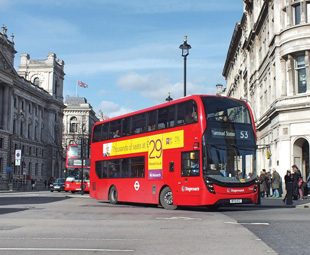Of change, charging and challenges

Let’s couple congestion with so-called technological progress (read: hybrid buses) that is now the rage in many developed countries
Everyone is trying to reduce emissions, and different countries and cities have started setting deadlines for stopping the production and use of internal combustion vehicles. And lately someone has also discovered a new concept called “in motion charging (IMC)”. Please Google it!
I had plenty of time to think about this a few months ago as I sat, together with two other passengers, upstairs in EH44; a London hybrid bus dragging its way northbound on route 42. There’s nothing special about route 42, except that it has crossed the iconic Tower Bridge since 1914.
Since 1943 it has shared the bridge with route 78, and since 2002 with route RV1, which currently has the distinction of being the only London route fully operated by hydrogen buses – eight of them.
EH44 is one of over 2 500 alternative-fuel buses on London’s streets, but I doubt that alternative fuels are making much difference to the pollution. An almost-empty hybrid bus probably churns out more particles per passenger than a car carrying four people.
I got on to EH44 at Camberwell Green at 16:55; a trip that was scheduled to arrive at the destination (Appold Street, in London’s business district) at 17:38. It got there at 18:08. Our delay was almost entirely caused by gridlock along the final stretch of about 500 m approaching the bridge itself.
I had planned to enjoy the view of the Thames, but decided instead to do a quick count of traffic going the other way. During the 90-odd seconds it took to cross the bridge: there were 57 vehicles. One was a bus on route 78, carrying about 40 people; fifteen were two-occupant cars or metered taxis; and 41 were single-occupant cars or metered taxis.
That means that 97 percent of the road space was occupied by 55 percent of the people and the remaining 45 percent were using only three percent. That’s a Gini-type of inequality that needs fixing in many places, including South Africa.
This brings me to the subject of hybrid transport economics. There are now so many options along a route that the number of hybrid scenarios has become infinite. We can now expect widely divergent claims about the economics of different types of motive power.
In Gdansk (Poland) researchers have found that trolleybuses fitted with high-capacity lithium-ion batteries could help out on diesel bus routes to the tune of 29 km. They’re not saying that IMC buses are cheaper to run; other research from Germany suggests that diesel buses will remain the most
economical bus technology (in Europe) until 2025.
A reorganised public transport network in every South African city will allow bus routes to be at least partially electrified right now, given the volumes of passengers currently travelling along them. IMC will allow smaller vehicles to use the system. No one seems to have thought about that yet!
Before we start rolling our eyes at the prospect of 15-seater minibus taxis with poles on the roof, I challenge anyone to come up with something better. How about a 30 or 45-seater bus? While we think, we can always make a start by electrifying the Moloto Road – a much more sensible idea than building a railway line.
Vaughan Mostert lectured on public transport issues at the University of Johannesburg for nearly thirty years. Through Hopping Off, Mostert leaves readers with some parting food for thought as he continues his push for change in the local public transport industry.
Published by
Focus on Transport
focusmagsa




